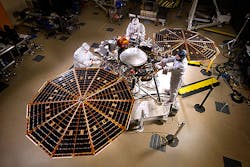Technicians at Lockheed Martin’s Space Systems in Colorado completed assembling the Insight Mars lander, preparing it for a series of performance tests in advanced of its scheduled launch in March 2016 for a robotic exploration mission.
“The assembly of InSight went very well, and now it’s time to see how it performs,” stated Lockheed’s InSight program manager Stu Spath.
InSight — the acronym is for “Interior Exploration using Seismic Investigations, Geodesy and Heat Transport” — is a two-year scientific mission for the NASA Discovery Program
that will place a single geophysical lander on Mars to study the planet’s subsurface. NASA noted that InSight “is a terrestrial planet explorer that will address one of the most fundamental issues of planetary and solar system science: understanding the processes that shaped the rocky planets of the inner solar system (including Earth) more than four billion years ago.”
Lockheed Martin Space Systems is a contractor to NASA's Science Mission Directorate for the InSight program, which is being directed by the California Institute of Technology’s Jet Propulsion Lab. The project’s science team includes U.S. and international co-investigators from universities, industry and government agencies. Also contributing are the French space agency CNES and the German aerospace center DLR.
Now assembled, the lander will be subjected to a series of tests to evaluate its performance during the launch and journey to Mars, as well as its ability to endure the entry to the Martian atmosphere before beginning operations on the surface.
“The environmental testing regimen is designed to wring out any issues with the spacecraft so we can resolve them while it’s here on Earth,” Spath explained. “This phase takes nearly as long as assembly, but we want to make sure we deliver a vehicle to NASA that will perform as expected in extreme environments.”
During the environmental testing phase, from now through the end of the year, the lander will be exposed to extreme temperatures, vacuum, and various tests through the end of the year. First will be a thermal vacuum test to evaluate the “cruise” configuration that the spacecraft will maintain during its seven-month journey to Mars. Following that will be of reverberant acoustic tests; separation and deployment shock tests; and electromagnetic interference and compatibility testing.
The testing phase concludes with a second thermal vacuum test wherein the spacecraft is exposed to the temperatures and atmospheric pressures comparable to the conditions the vessel will encounter on the surface of Mars.
The InSight is scheduled to launch from Vandenberg Air Force Base in California next March.
“It's great to see the spacecraft put together in its launch configuration,” stated NASA’s InSight project manager, Tom Hoffman. “Many teams from across the globe have worked long hours to get their elements of the system delivered for these tests. There still remains much work to do before we are ready for launch, but it is fantastic to get to this critical milestone.”
About the Author
Robert Brooks
Content Director
Robert Brooks has been a business-to-business reporter, writer, editor, and columnist for more than 20 years, specializing in the primary metal and basic manufacturing industries.
